I always wanted to see the Northern Lights. To me, it was something magical, a completely different experience, seeing the sky painted in different shades of green, blue, pink, purple….
And Iceland, that little piece of land, isolated, made of volcanic material, at the entrance to the Arctic Circle, has always fascinated me. Iceland has been on my radar for some time … It was just a matter of planning (and preparing my pocket) to face this adventure and accomplish two of my travel dreams.
I will tell in this post our whole experience and itinerary in Iceland. What I can say, right away, is that it was an unforgettable trip.
The Northern Lights
First of all: What are the Northern Lights anyway?
The Northern Lights happen when particles of solar explosions impact in our atmosphere. These particles are attracted by the magnetism of the poles; for this reason, the more proximity to the poles, the greater the chance of seeing the northern lights. The best season for “hunting” the lights is in the winter, because the nights are longer and darker.
But is it really that amazing?
I imagine that many people that travel to Nordic countries have high expectations of seeing the Northern Lights. The first thing people need to remember is that Northern Lights are a natural phenomenon. Although there are instruments that predict the intensity of the Lights, it’s always uncertain if you will be able to see them. And the beautiful pictures we see of them don’t always reflect the reality. Some cameras can actually capture more of the Northern Lights than our eyes can see.
Also, the Northern Lights don’t always stand still in the sky. They can come and go in a matter of seconds. So seeing them is often a game of patience: you may need to spend minutes, or even hours on the outdoors, in the cold winter.
We were very fortunate to get clear skies and even so, in some nights we had to wait a couple of hours for the Northern Lights to appear. Some friends of ours who weren’t so patient didn’t get to see them as we did.
But maybe it’s because they are so unpredictable that is so exciting. Watching the Northern lights is a mixture of anxiety, excitement and fascination. It’s that “I cannot believe it” feeling. So, answering the question: Yes, it is wonderful, exciting, incredible… it is beyond all expectations!
But Iceland is much more than just a place to see the Northern Lights.
Iceland
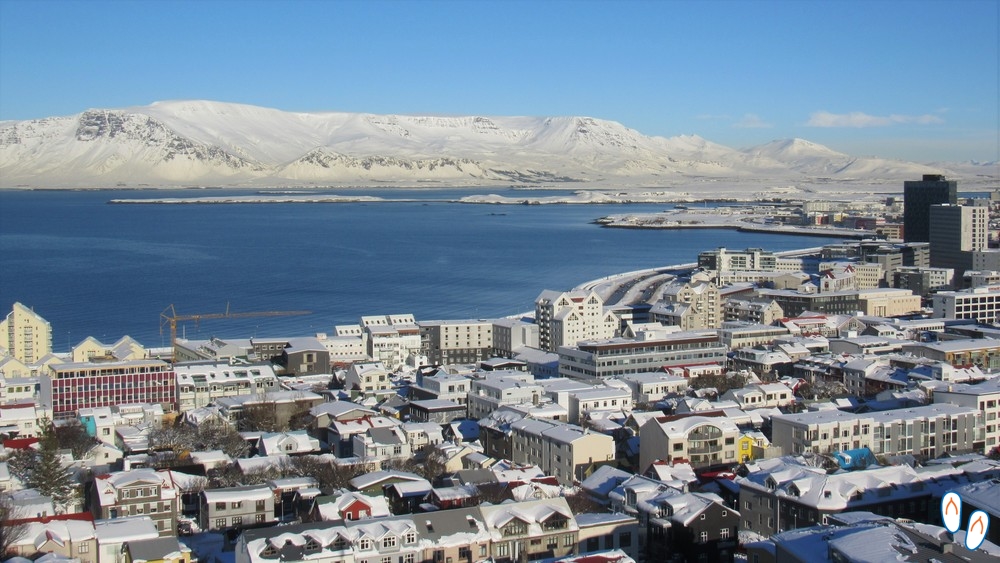 Reykjavik, Iceland’s capital, seen from the top of Hallgrímskirkja church.
Reykjavik, Iceland’s capital, seen from the top of Hallgrímskirkja church.
Currently Iceland is one of the most developed countries in Europe. But it hasn’t been always like this. Iceland has already belonged to Norway and Denmark, has been raided by pirates, and has suffered from severe epidemics. All of this, combined with a very challenging climate and several volcanoes, made Iceland a troubled country for centuries and one of the poorest in Europe.
Fortunately, in the twentieth century, after its independence, and with the strengthening of the economy based mainly on the fishing industry, Iceland managed to turn the table. And things are a little bit easier when you have a population of just over 300 thousand inhabitants.
Iceland is not part of the European Union, so the local currency is the Icelandic Krona. It is important to exchange money, since most places do not accept dollars or euros. And prepare your wallet: in Iceland, almost everything is imported so, everything is expensive.
The official language is Icelandic, it has those giant words that are difficult to pronounce. But you can do just fine in English!
The weather is unpredictable. Despite its small size, the climate in the north is much colder than in the south and quite unstable. The landscape changes completely according to the season. The “Summer Iceland” (which I still want to visit), with all greenish vegetation and blue lakes, is completely different from “Winter Iceland”, where white snow predominates and several lakes even freeze.
For those who want to experience “Winter Iceland” and search for the Northern Lights, I recommend hiring a travel agency. The weather conditions in Iceland can make driving a challenge. Not rarely roads are closed or cars get stuck in the snow. Also, tours can be cancelled or infeasible.
A local team makes all the difference, knowing what is safe or not to do, which tours will be more appropriate in the right conditions… Even for searching for the Northern Lights, they know the best places to go.
For our trip to Iceland we hired a Brazilian agency called Terramundi. They are specialized in customized and non-conventional packages. It is more expensive than going on your own, but I think it’s worth it for the quality of their service and for not having to worry on small details. This was our 6th trip with Terramundi, they are our main partner for guided tours.
Our itinerary
Our itinerary in Iceland had 5 nights, beggining in the capital, Reykjavik, and traveling through much of the south coast, to Vatnajokull National Park. We were really lucky with the weather. Two days before our arrival, there was the biggest snowstorm Iceland has seen for the last 40 years. The landscape got all snowy bright white, and it cleared the sky for the next days.
All of those things contributed for a trip of “not-so-cold” weather and nights of Northern Lights sightings. According to our guide, the temperature we got was relatively high for this time of the year – the minimum was -10ºC. But still, it requires several layers of clothing.
Reykjavik
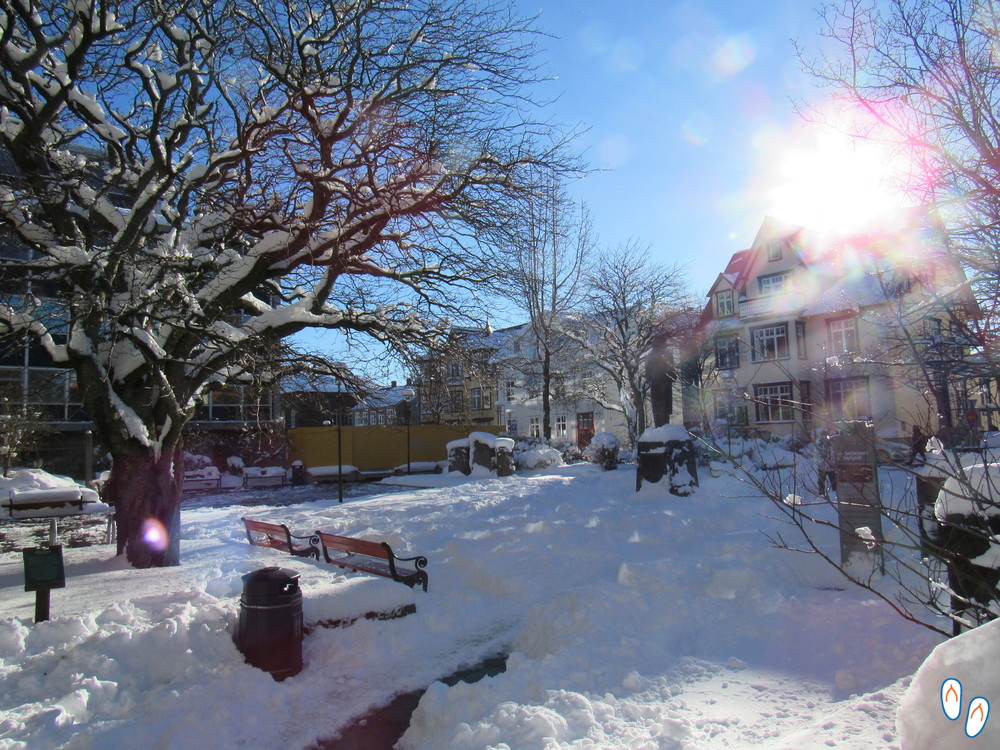 Beautiful Reykjavik square all covered in snow.
Beautiful Reykjavik square all covered in snow.
We spent our first day mostly in the Reykjavik area. The architecture of the city is actually quite simple, which is different from other European cities. No large buildings, looking more like a small town, what makes it super charming.
Our small tour in Reykjavik included:
• Eating the famous hot dog that is considered by many the best in the world;
• The Harp – an Auditorium / Conference Center, beautiful and modern building;
• The amazing Hallgrímskirkja, a luteran church that is the tallest in Reykjavik.
In the front of the church there is a statue of Leif Erikson, Viking and navigator known for having discovered North America before Christopher Columbus. Inside the church you have the option to go to the top, from where you have a very nice view of the city.
 The beautiful Hallgrímskirkja in Reykjavik. In front of the church, Leif Erikson’s statue.
The beautiful Hallgrímskirkja in Reykjavik. In front of the church, Leif Erikson’s statue.
We took a boat tour from Reykjavik, for Minke Whales sighting. It was so cold in the boat that they gave us a special outfit. The tour is nice, the landscape is so beautiful, having the view of Iceland from the ocean. Unfortunately the whales were shy on that day. The sighting is not guaranteed, and they do not refund your money, but we did receive a voucher that is worth for a new tour valid for 1 year.
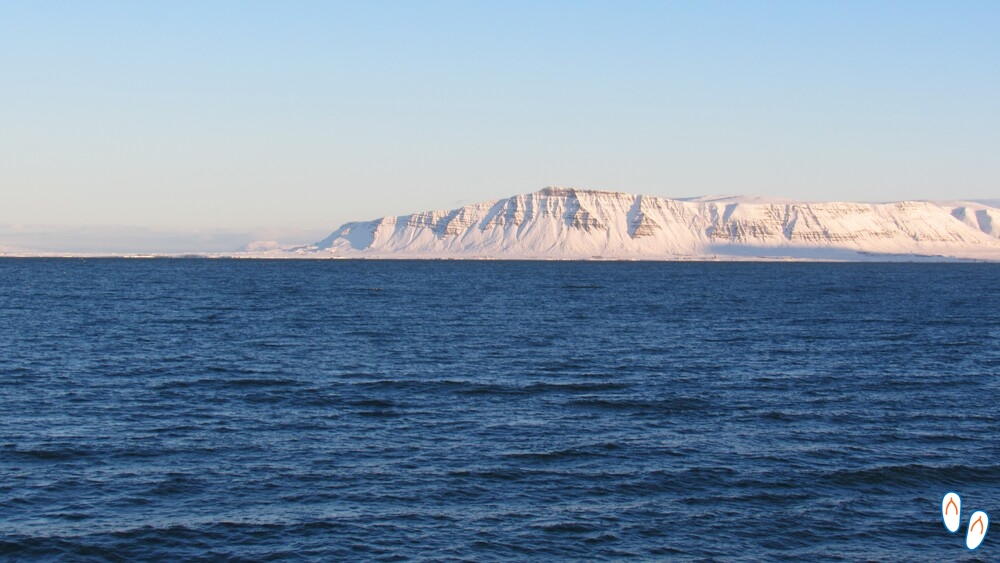 View of Icelandic snowy mountains from the boat.
View of Icelandic snowy mountains from the boat.
Blue Lagoon
We finished our first day in Iceland in the Blue Lagoon, one of Iceland’s most famous attractions. The Blue Lagoon is a thermal station, constructed artificially, but with warm waters from a geothermal station located on top of a lava field. The pools have clean water at a temperature of about 38°C, and it is rich in minerals such as silica. Because of the silica, people say the baths in the Blue Lagoon are not only invigorated but also good for the skin.
The site has a structure for visitors, and offers packages starting at 6690 kronos (approx. USD 67.00 – values in 2017). The simplest package gives the visitor access to the ponds, a towel, and allows the visitor to use the shower and store your belongings. In the complex there is also a restaurant and a hotel. It is a very touristic place, no doubt about it, but the relaxing bath in those warm waters is delicious, not to mention the beautiful view of the steam coming out of the water amidst a snow-covered landscape.
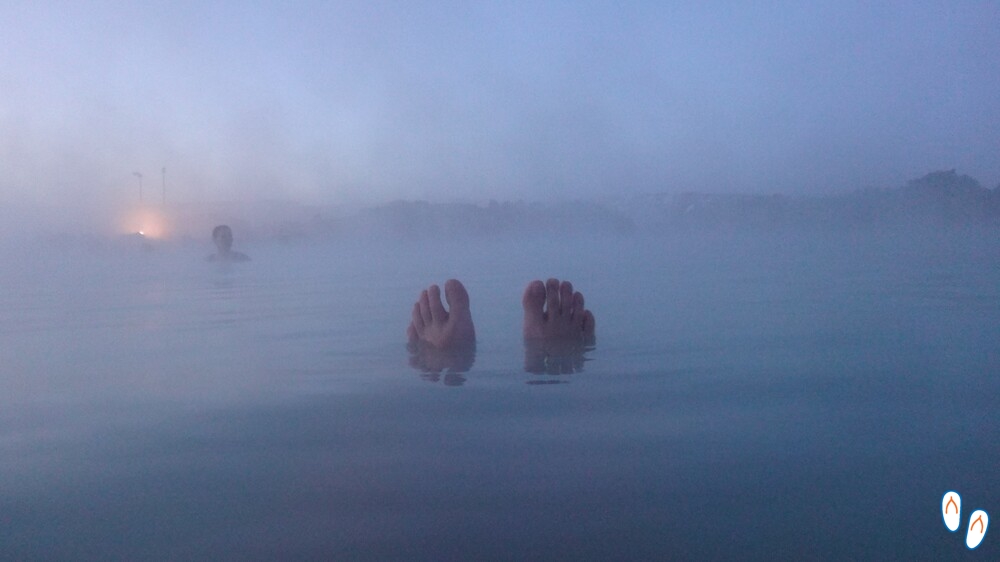 Relaxing in Blue Lagoon
Relaxing in Blue Lagoon
Our experience at Blue Lagoon was not only delicious but also brought us a great surprise. After getting out of the bath, when I was serving myself a snack in the cafeteria, our guide comes running and says “Leave the snack here, go see the ‘aurora’ outside!” And I said, “What?? How is that so?? It’s only 7PM!” “Hurry, leave it all here and I’ll take it to you,” he said.
And there it was!!! A green line emerging from the horizon, and lost in the immensity of a starry sky. “Our first ‘aurora’” I thought! We were all overwhelmed, everyone staring up at the sky, fascinated, on a night we were not even supposed to look for it, and it was not even so dark yet. And it lasted long enough for us to watch. We were happy to have already guaranteed one night of Northern Lights!
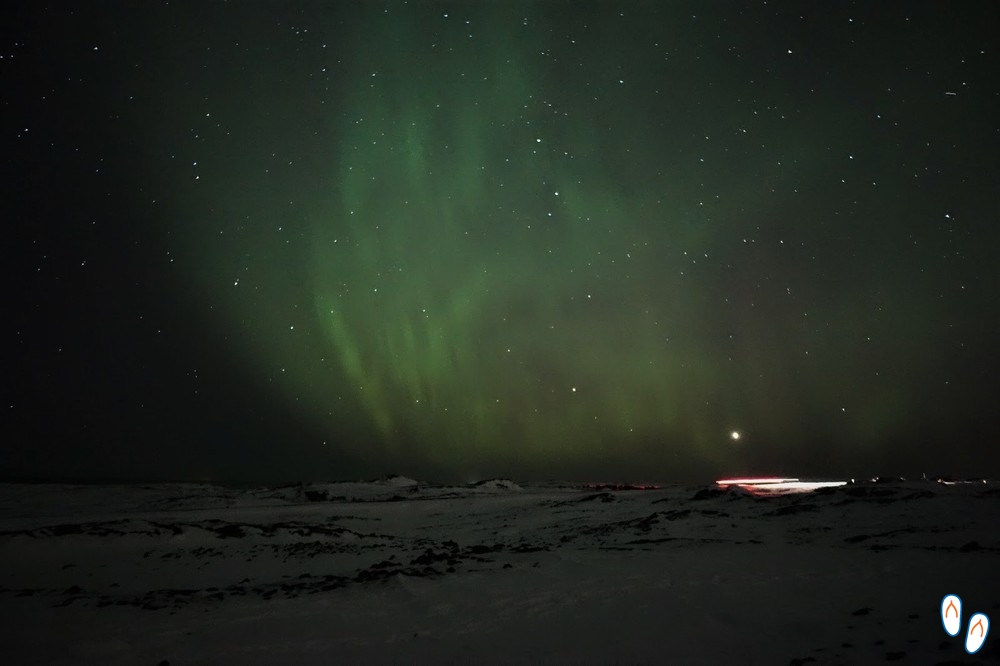 “Aurora” (Northern Lights) Picture from Claudia Bernasconi and Edu Fullen
“Aurora” (Northern Lights) Picture from Claudia Bernasconi and Edu Fullen
On our way back to Reykjavik, we stopped a few times in our “Northern Lights hunt expedition”. Usually the guides take us to more remote places where visibility is greater. I tried several times to photograph it…. but all in vain… How did I not think it through?? Nocturnal photos usually require professional cameras… fortunately a few people in our group have managed to record that moment.
As we approached Reykjavik, however, it was harder to see the Northern Lights, much because of the city’s own lights, which dim the brightness of natural lights. Nevertheless, in the next day, we discovered from a colleague in our party that the Northern Lights were visible in Reykjavik at 3AM!
Thingvellir National Park and The Golden Circle
On our second day, we left from Reykjavik to Thingvellir, a National Park which is of historical importance because it is the site of the former National Parliament and also the place where Iceland’s independence was proclaimed. In addition to the historical importance, this place attracts many tourists because of the impressive lava formations and also because it is the only place in the world where it is possible to see the division of two tectonic plates, the North American and the Eurasian.
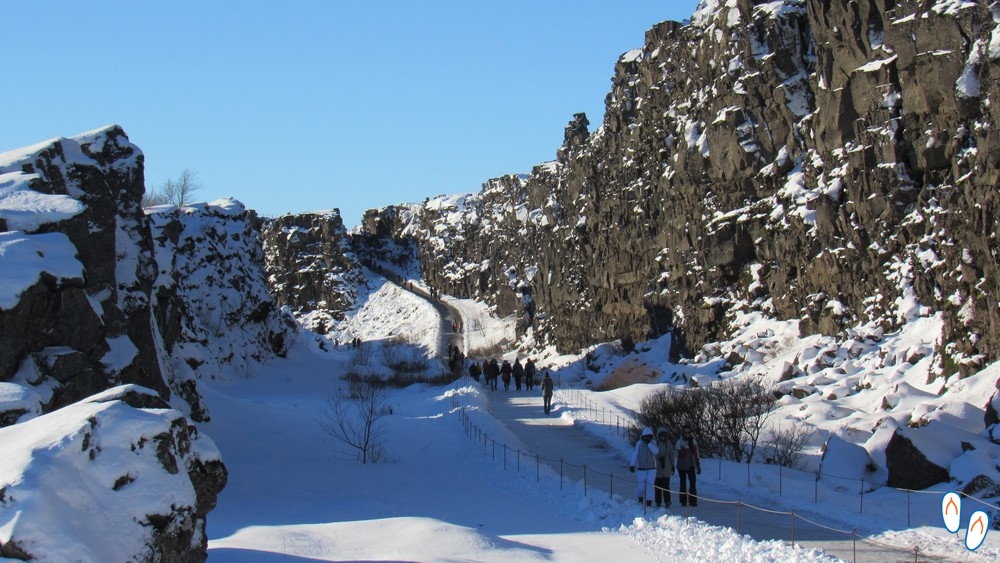 In Iceland and, at the same time, in America: At Thingvellir National Park the visitor walks between 2 tectonic plates
In Iceland and, at the same time, in America: At Thingvellir National Park the visitor walks between 2 tectonic plates
Our second stop was at the Friedheimer restaurant, a place that is actually a indoor tomato farm. The soil and climate in Iceland make it impossible to plant anything regularly. This family found a way to plant tomatoes in a large greenhouse, with temperature and humidity control, and had the great idea of opening a restaurant to serve people. One of the most popular dishes is the tomato soup.
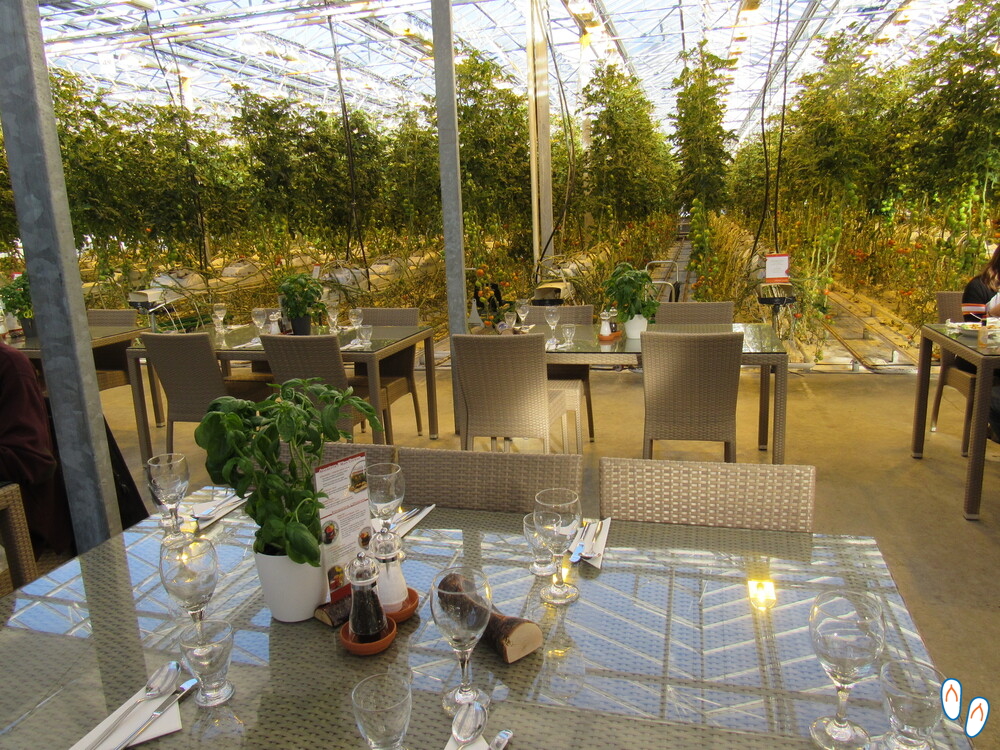 Friedheimer restaurant with its indoor tomato farm.
Friedheimer restaurant with its indoor tomato farm.
Our next stop was at one of Europe’s most famous waterfalls, the Gulfoss, which stands for the Golden Waterfall. The waterfall is fed by Langjokull Glacier, and the volume of water is so immense, that even at a distance, it was possible to feel the splash of water.
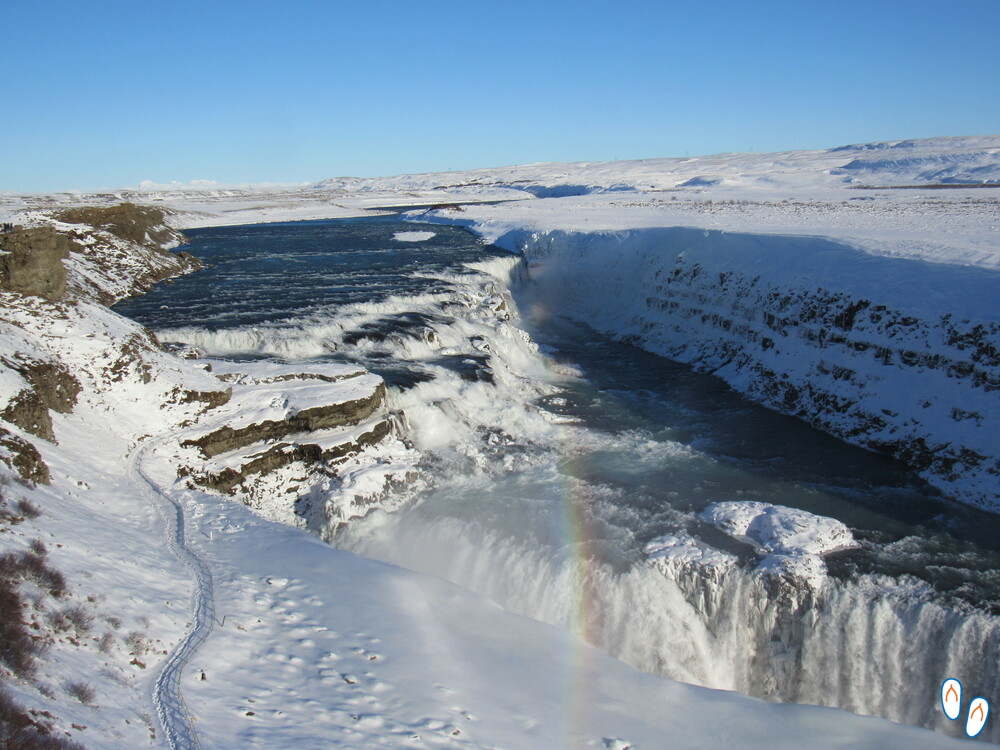 The amazing Gulfoss – the water spray formed a small rainbow
The amazing Gulfoss – the water spray formed a small rainbow
In this same area, known as Golden Circle, there is the Geyser – a hot spring that blows water and steam with a certain frequency.
Geysers are the result of the high pressure of water vapor formed by the volcanic lava. The water rises violently when the space beneath the earth cannot withstand the pressure. Geysers can reach several meters of height; always in very high temperatures, so it is very important to keep distance from a geyser.
Geysers are not unique to Iceland, you may find them in Yellowstone, Atacama or New Zealand… But the thing is that the very word Geysir, is Icelandic, and originates from this exact spring, which takes the name Geysir itself.
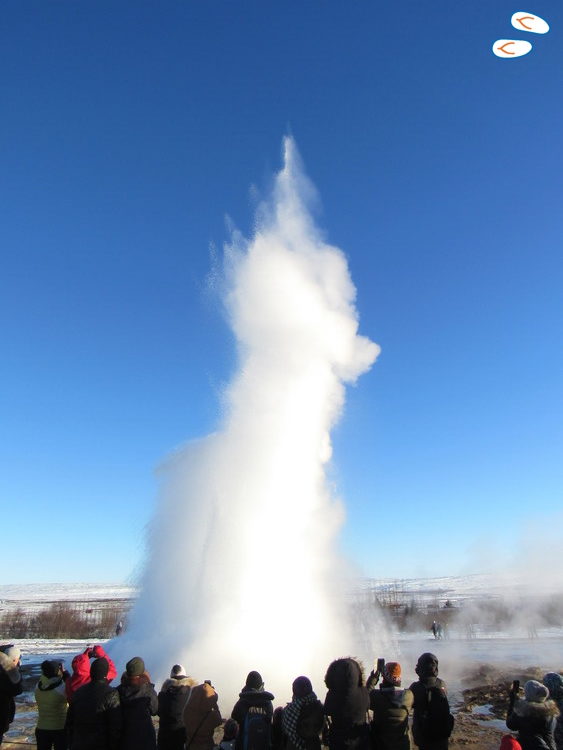 Geysir
Geysir
After visiting the Golden Circle, we moved on to the city of Hella, where we would spend the night in the excellent Stracta Hotel Hella. There we would look for the Northern Lights again.
One tip for anyone looking to keep track of the Northern Lights occurrences in Europe is to look at sites like Aurora Service that show the “kp” indicator. Basically the higher the “kp”, the greater the incidence of the Lights in that region, and the greater the radius of visibility that it reaches. Our guides followed these indicators daily to determine the days that we would do the “Northern Lights Hunt Expedition” (which in the end were almost all of them).
The interesting thing about the Stracta Hotel is that most rooms are small cottages. That means that, if you are looking for Northern Lights, you can just open the door and look at the sky. And that’s exactly what happened! Suddenly people start to warn us that there were Northern Lights, and we just stepped out of the room. It really was very beautiful – and shinier than the day before!
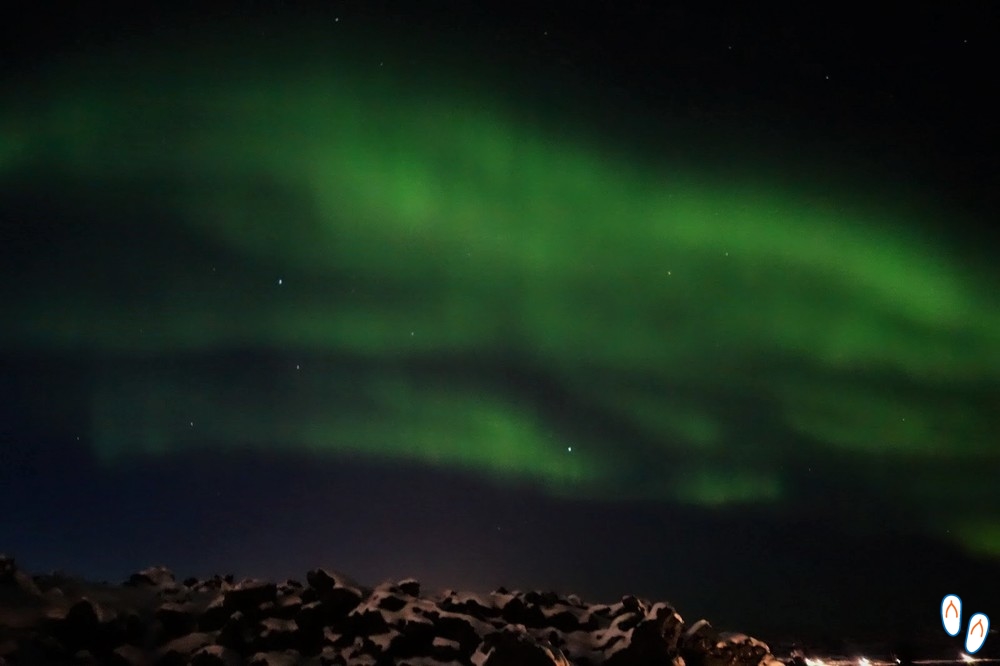
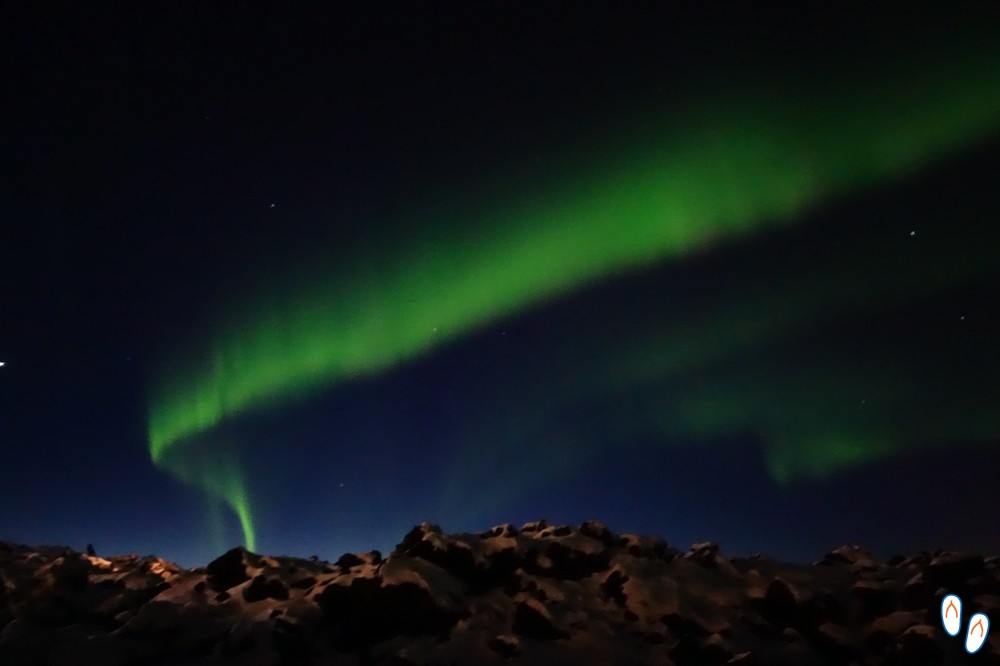 Another night with Northern Lights – Pictures from Claudia Bernasconi and Edu Fullen.
Another night with Northern Lights – Pictures from Claudia Bernasconi and Edu Fullen.
Skógafoss
We started our 3rd day in Iceland in Skógafoss, a beautiful waterfall that is one of the highest in Iceland – it is 60m high. You may climb the stairs on the side of it and see it from above!
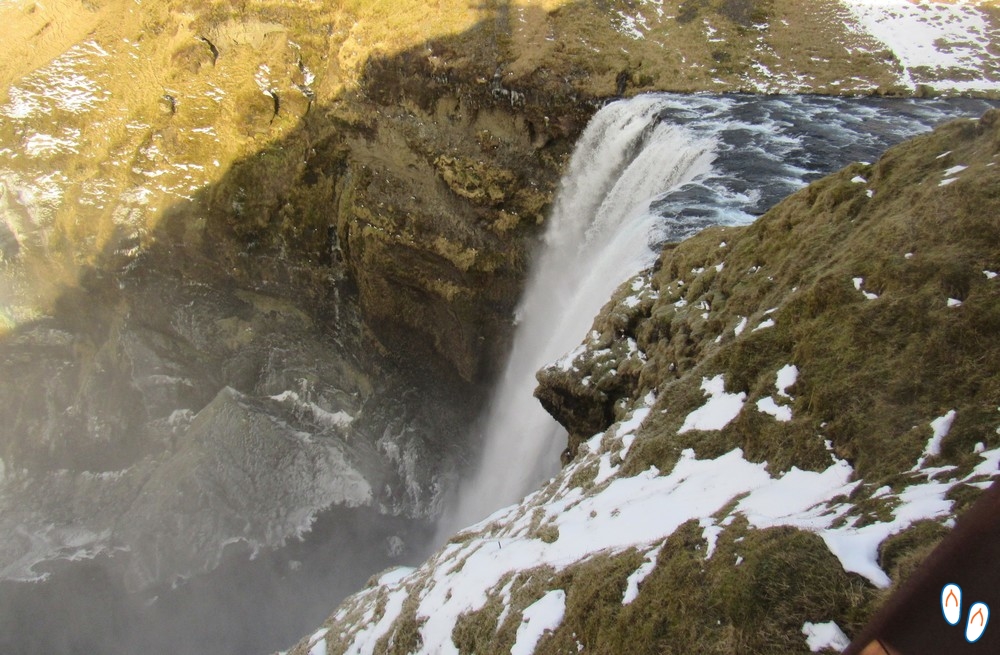 View from the top of Skógafoss waterfall.
View from the top of Skógafoss waterfall.
Reynisfjara Beach
Next we visited one of my favorite places in Iceland – the black sand beaches of Reynisfjara! Not only the beach itself is amazing, full of small volcanic stones, but also you’ll find a spectacular view right beneath the mountain, where the basalt stone columns form a small cave. The basalt formations are so geometric that it is hard to believe that it is a natural formation!
If you look towards the sea, you’ll find other formations called Reynisdrangar, next to the mountains, to which there are several legends associated.
Close to Reynisfjara Beach there’s also the charming village of Vík – a village among the mountains overlooking the Reynisdrangar formations.
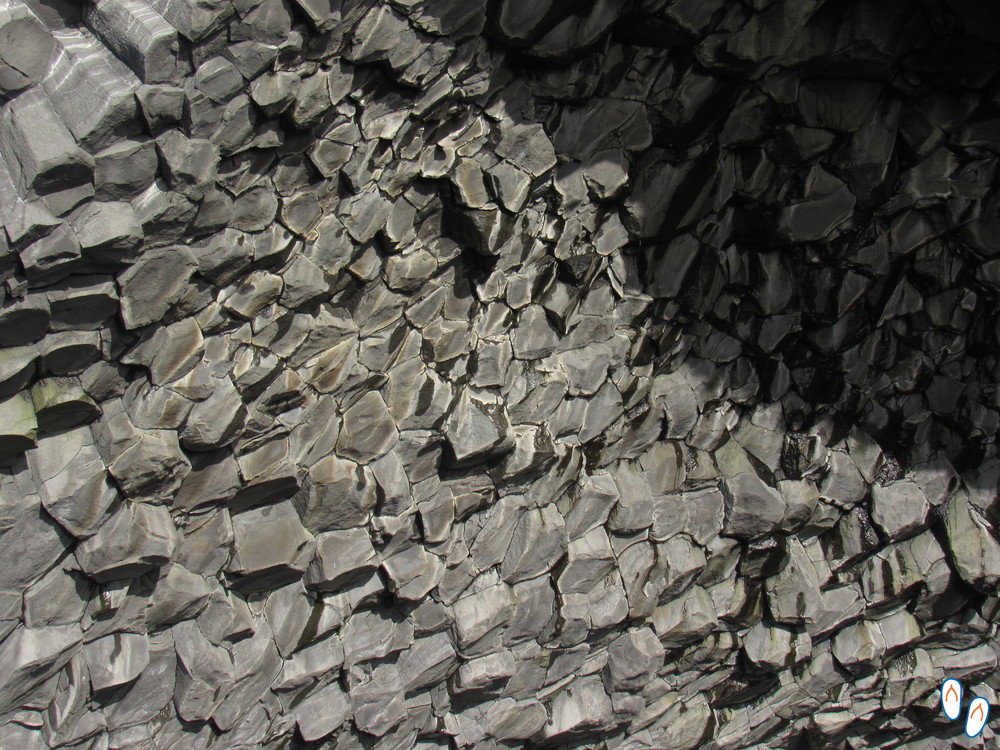 Amazing look in the interior of the cave formed by basalt columns in Reynisfjara Beach!
Amazing look in the interior of the cave formed by basalt columns in Reynisfjara Beach!
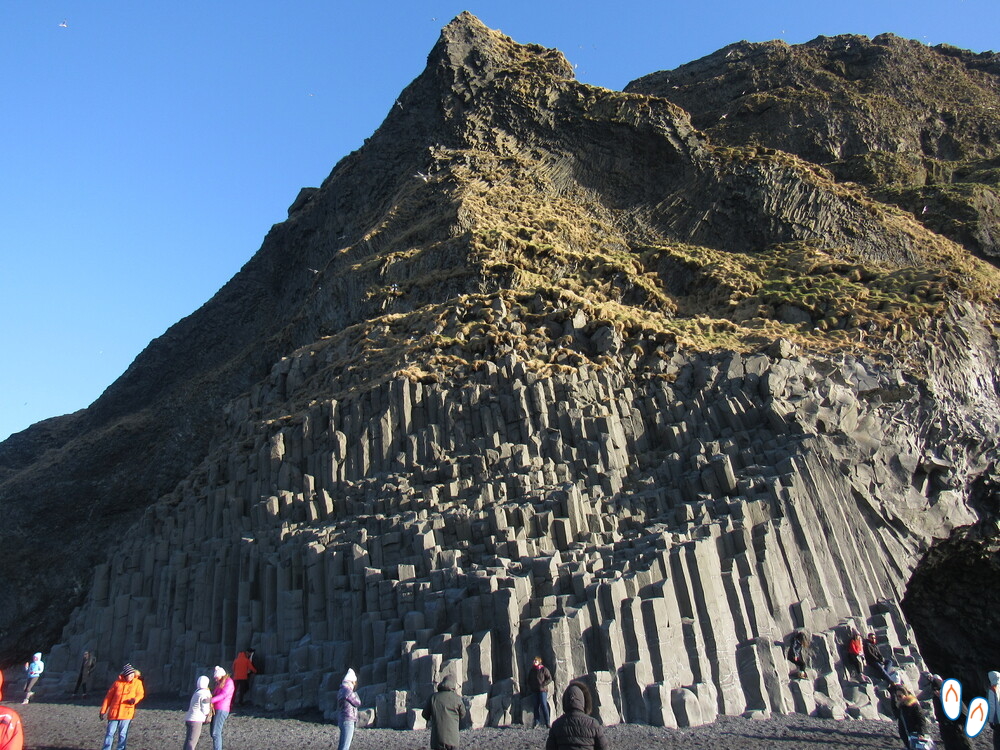 Geometric Basalt Columns in Reynisfjara Beach, South Iceland.
Geometric Basalt Columns in Reynisfjara Beach, South Iceland.
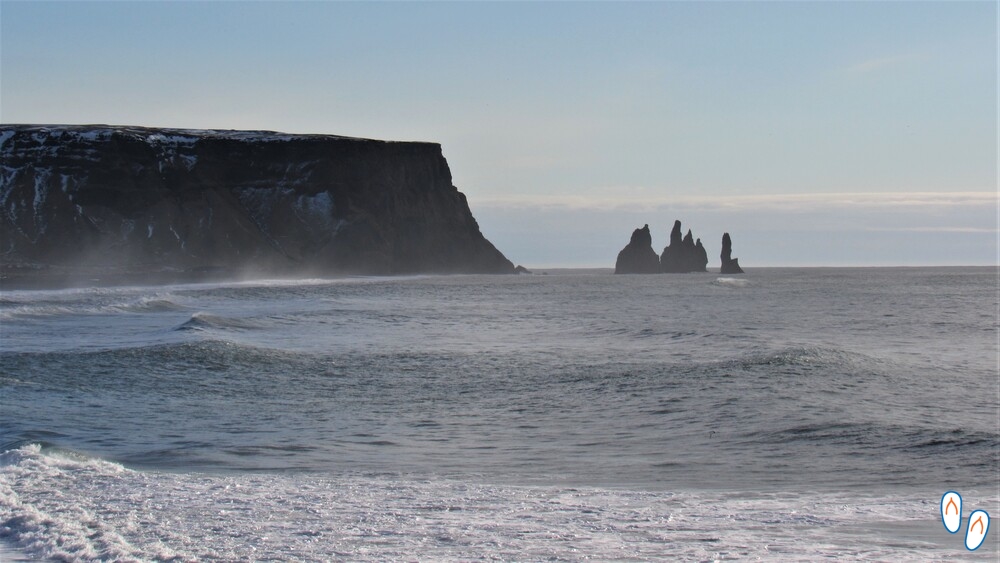 Reynisdrangar, basalt formations near Reynisfjara black sand beaches.
Reynisdrangar, basalt formations near Reynisfjara black sand beaches.
Vatnajokull National Park
From the black sands of Reynisfjara we went to the blue and white immensity of Glacier Lagoon, a glacial lake which is filled with small icebergs, pieces of the Vatnajokull Glacier that got loose and end up in the lake.
But the icebergs do not stay in the lake for long. Gradually they head towards the sea. So, moving on a little further, you’ll find Diamond Beach – a beach where you literally walk among the icebergs! All of this is within the Vatnajokull National Park – a must-see in Iceland!
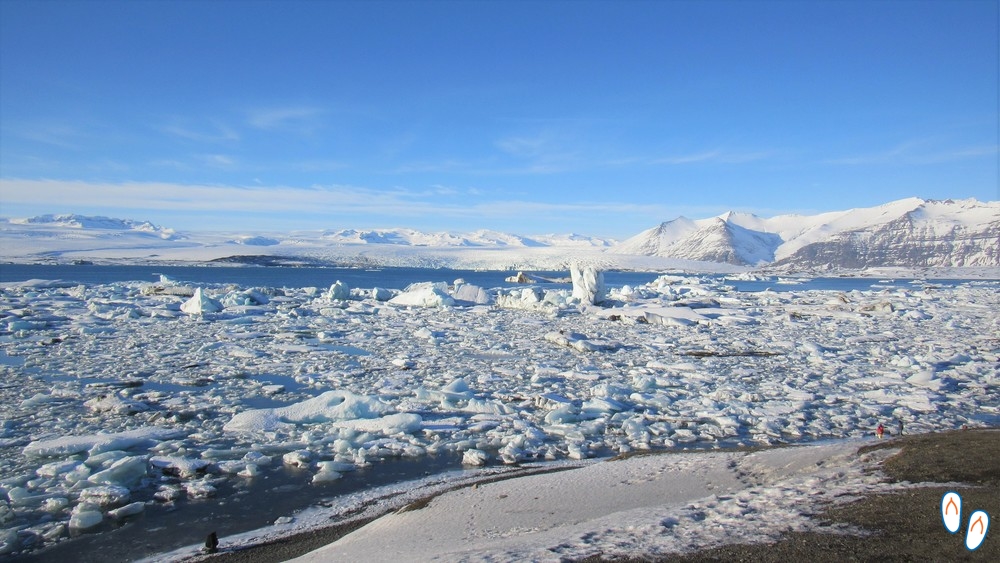 Glacier Lagoon, Vatnajokull National Park, Iceland
Glacier Lagoon, Vatnajokull National Park, Iceland
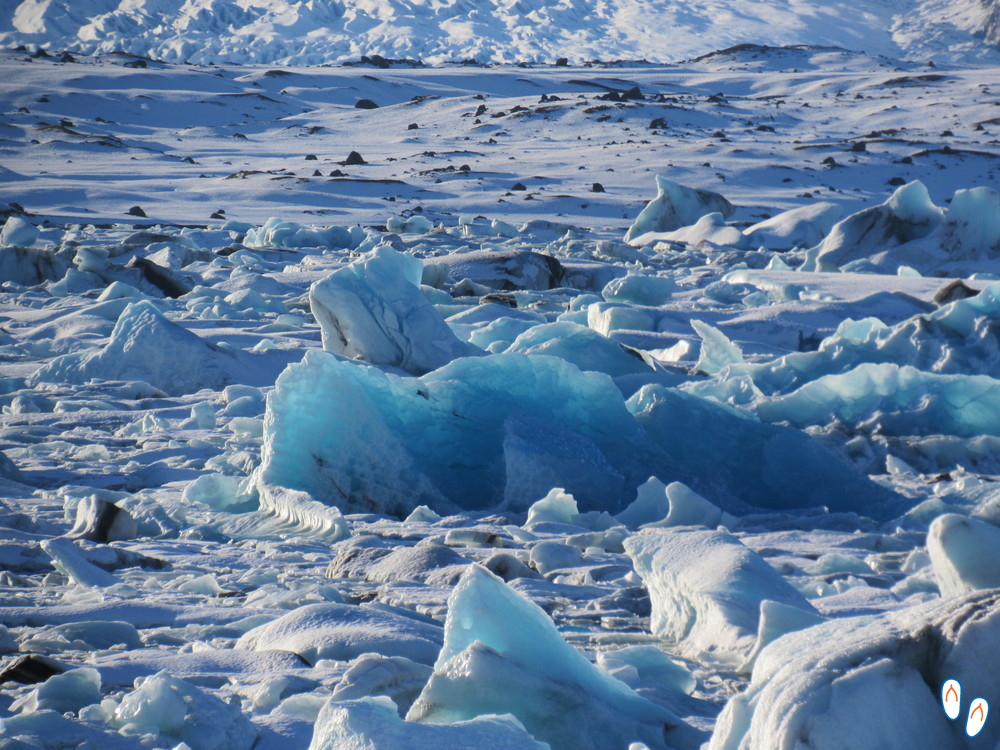 Icebergs in Glacier Lagoon
Icebergs in Glacier Lagoon
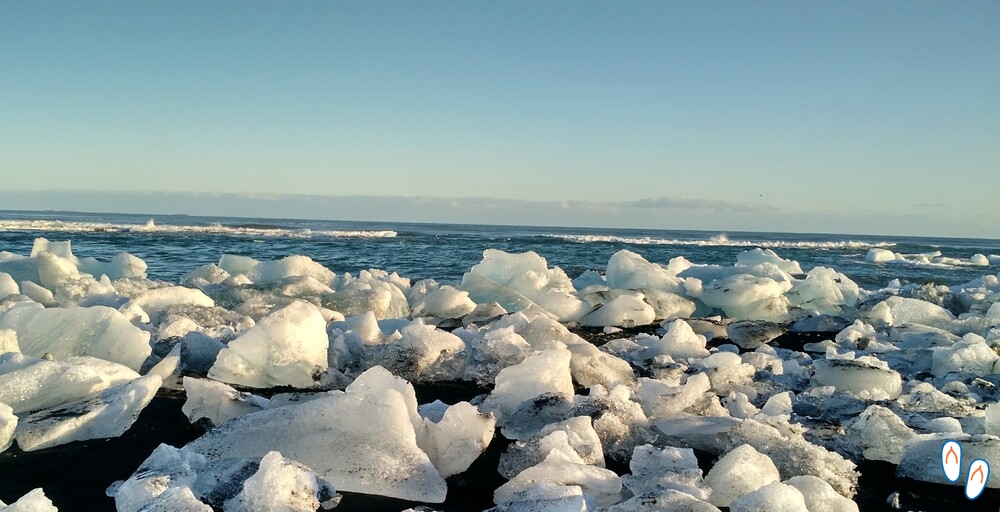 Icebergs that end up in Diamond Beach
Icebergs that end up in Diamond Beach
We continued our journey to Fosshotel Glacier Lagoon – once again, accompanying the “kp’s” through the internet, with great expectation for another night of Northern Lights! The hotel was literally in the middle of nowhere. From the outside one could only see the mountains on one side and the sea on the other.
As it began to darken, the sky started to show some greenish tones, which grew a little stronger from time to time, and then weakened. The night was long, we dined at the hotel, always with someone from the group with an eye on the outside, but without much change.
After 10PM, some people began to feel tired and, little by little, many gave up. In the end, we were 5 “survivors” who tooked turns looking at the outside area while the others stayed at the hotel’s warm reception.
I think it was about midnight when someone saw a stronger flash that we all decided to go look at. At that moment, the sky lit up. Different shades of green and pink took over the sky, beginning to scribble quickly and uncontrollably like a child drawing without much coordination. It was all very fast, but it was a general excitement. We screamed and pointed all over the place at the same time. It was unforgettable. I had never seen anything like it before, and I never imagined it would be like this.
These “aurora bursts” repeated a couple of times that night, until we went to sleep. The last of them we were able to see from our bedroom, from the large window we left uncovered and watched them lying on the bed.
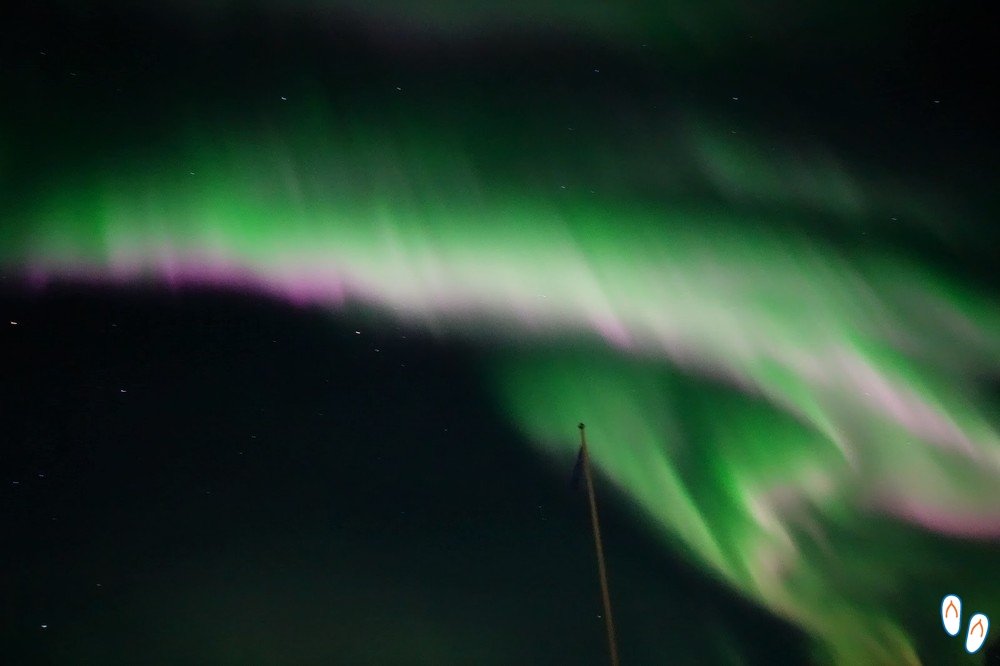 Northern Lights, one of the strongest we witnessed. Pictures by Claudia Bernasconi and Edu Fullen
Northern Lights, one of the strongest we witnessed. Pictures by Claudia Bernasconi and Edu Fullen
Solheimajokull Glacier Trekking
On our last full day in Iceland the main attraction was the walk on the Solheimajokull Glacier. I had already experienced glacier trekking in Argentina, in the Perito Moreno Glacier, but I believe that each one is different from the other.
For anyone who is in Iceland on their own, I recommend looking for one of the accredited companies at Skaftafell National Park to do this activity. Usually companies provide all the equipment such as staples and helmet. But it is advisable that people wear sneakers or hiking boots for this one.
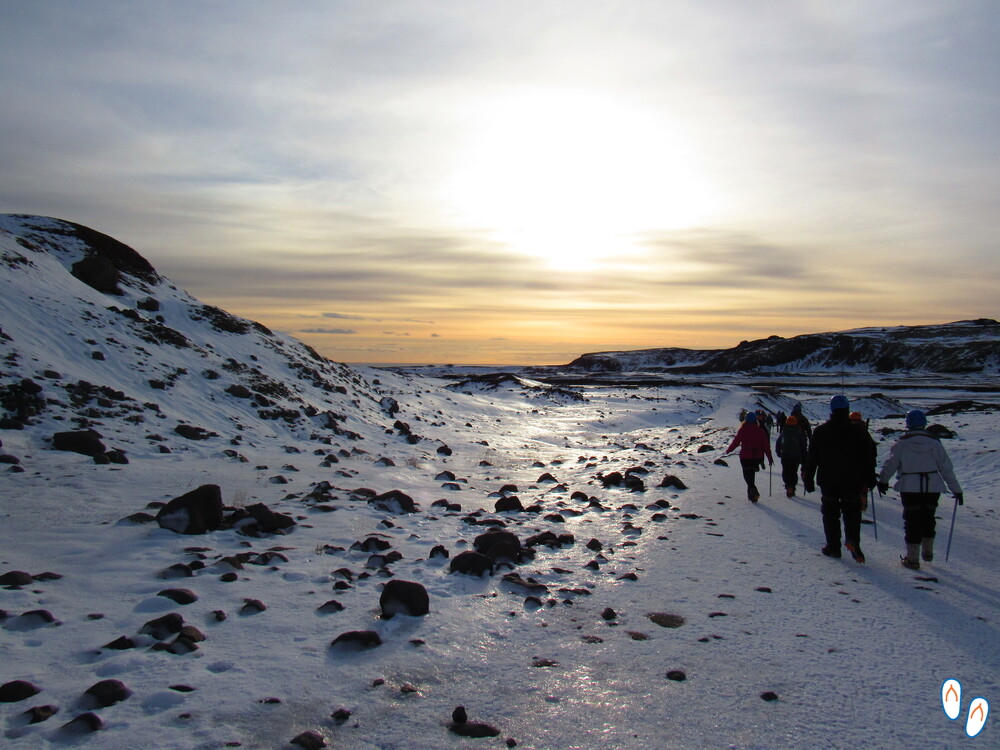 Walking towards to Solheimajokull Glacier, Skaftafell National Park, Iceland.
Walking towards to Solheimajokull Glacier, Skaftafell National Park, Iceland.
 View from above Solheimajokull Glacier
View from above Solheimajokull Glacier
The trekking on the glacier is a bit steep but without major difficulties. It begins with a small walk by the frozen lake to arrive at the glacier. Then the guide takes you inside the glacier, passing through a few ice walls, with different variations of blue and dark tips, mark of the natural dust. The view from the glacier is so different and amazing.
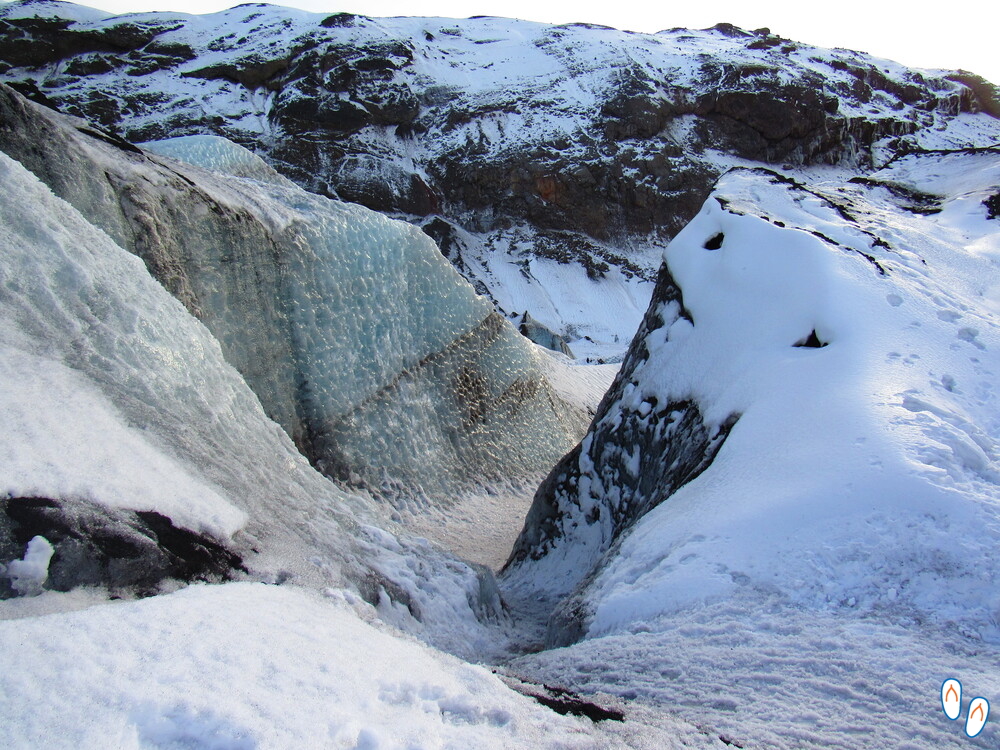 Walls of ice and snow in Solheimajokull Glacier
Walls of ice and snow in Solheimajokull Glacier
Seljalandsfoss
Already on our way back to Reykjavik, our last stop was in Seljalandsfoss, a beautiful waterfall in which usually one is able to pass behind the waterfall into a small cave and look at the waterfall from the inside out.
Unfortunately on that day the ground was very slippery with all the ice and so the passage to the inner part was closed, so we just looked at it from the outside!
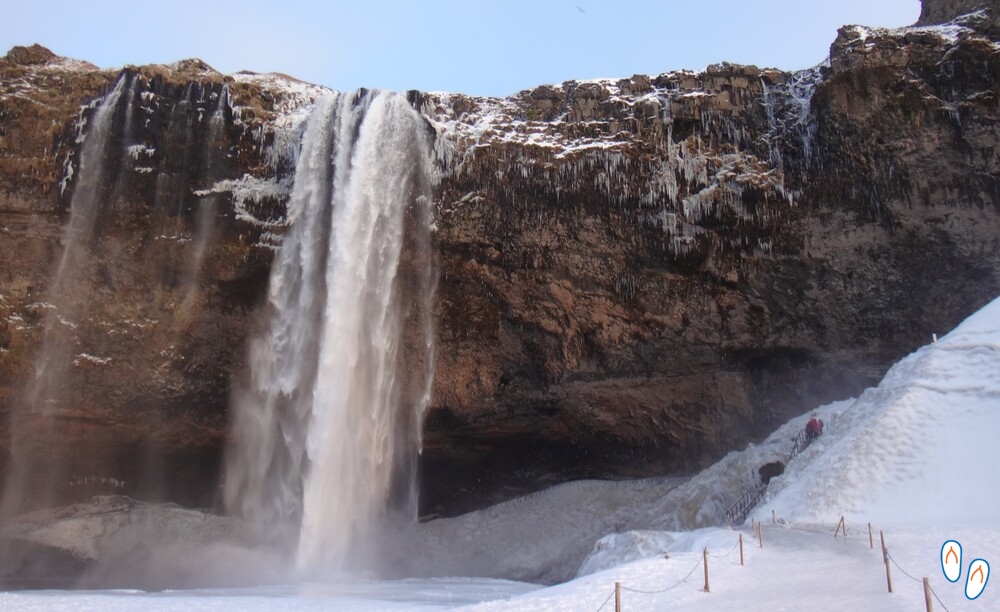
Seljalandsfoss Waterfall, Iceland
With the end of the scheduled tours, we returned to the capital Reykjavik, where we stayed at the excellent Fosshotel Reykjavik. We could enjoy a little more of this pleasant city! The next day we would board early on a flight back to London.
These few days in Iceland were unforgettable! It is amazing how this small country has managed to give us such extraordinary moments. For the country’s own natural landscape, so different and so beautiful, and also for the unforgettable experience of sighting the Northern Lights, one more colorful than the other.
We fell in love with Iceland. And we only visited the southern part of the country. There are many beautiful places to visit in northern Iceland too. But we’ll save that for another trip! 😉
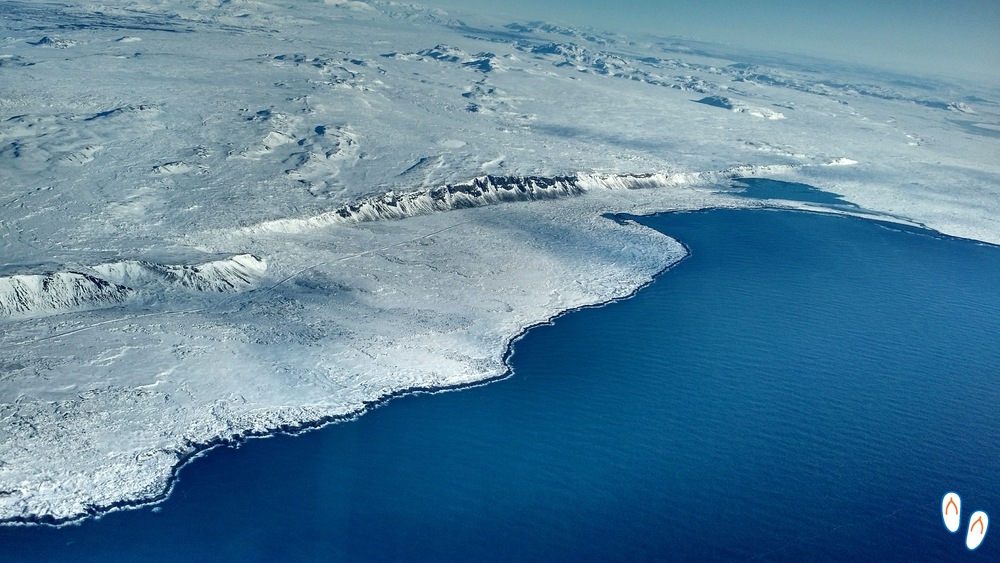



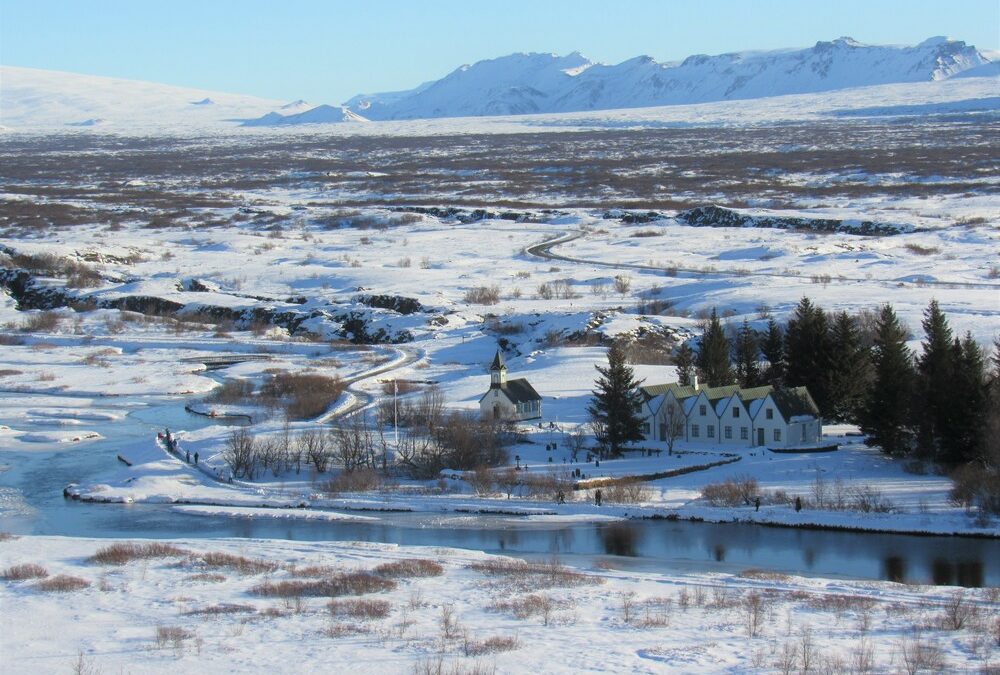
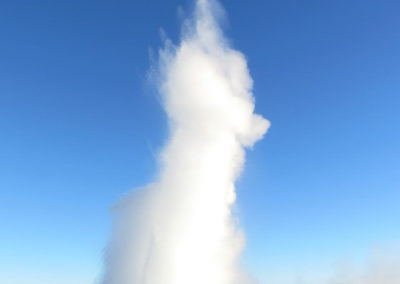
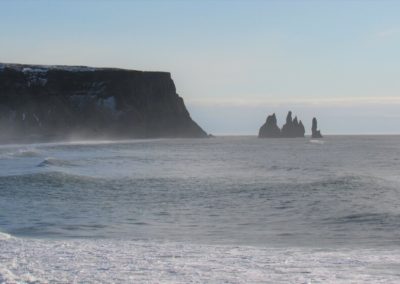
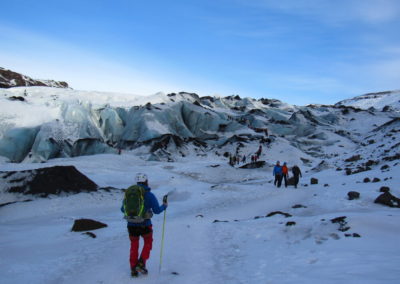
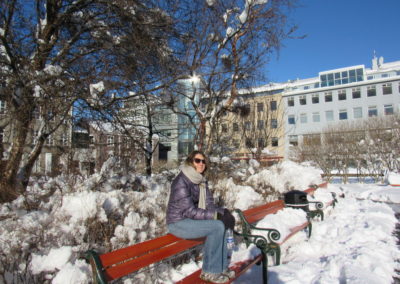
![reykjavik-1]](https://flipflops.blog/wp-content/uploads/2019/11/reykjavik-1-400x284.jpg)
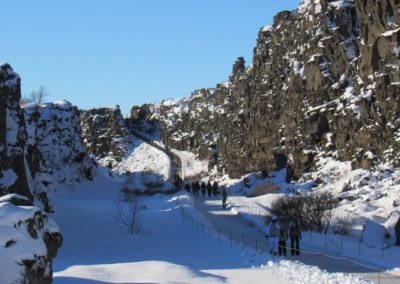
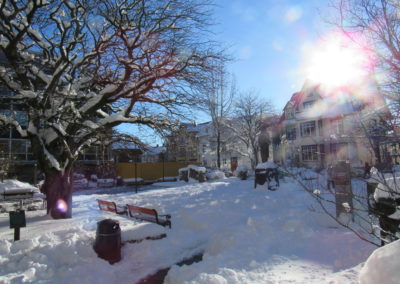
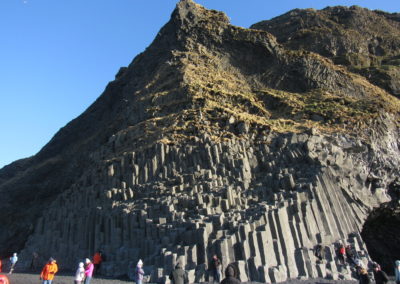
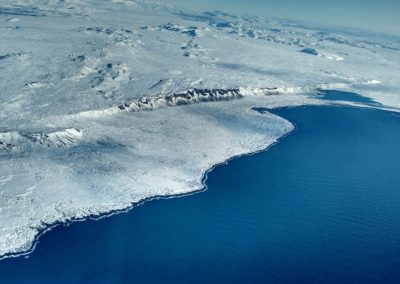
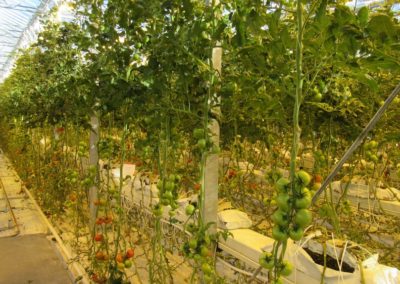
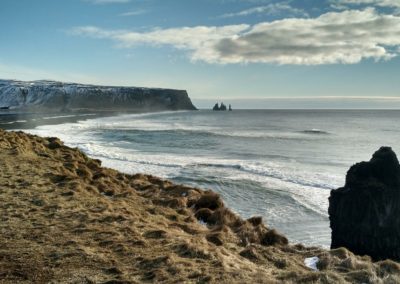
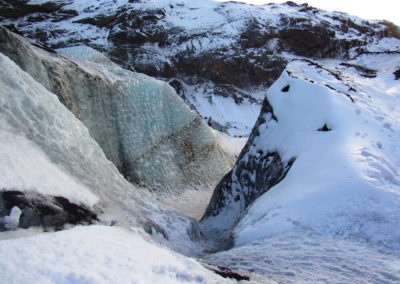
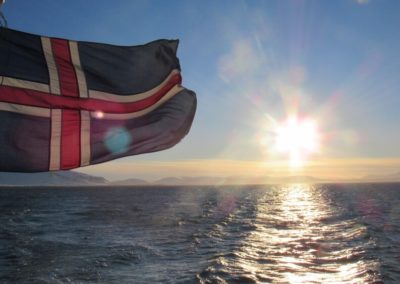
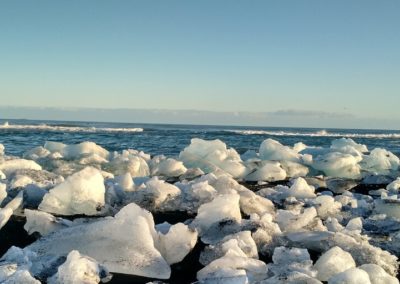
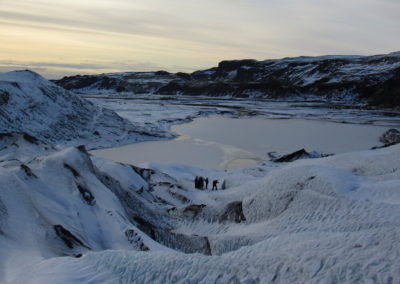
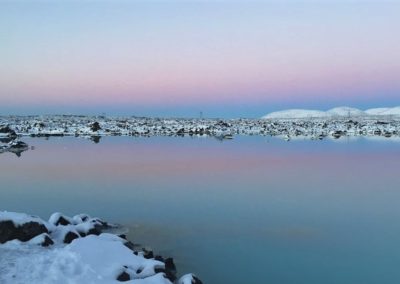
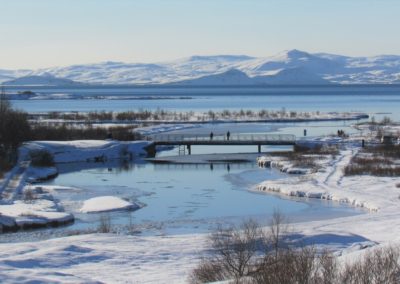
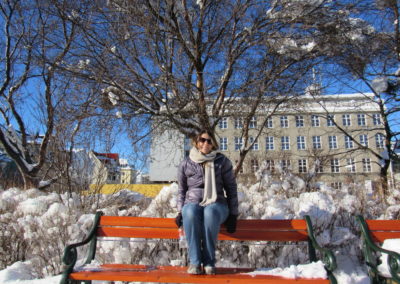
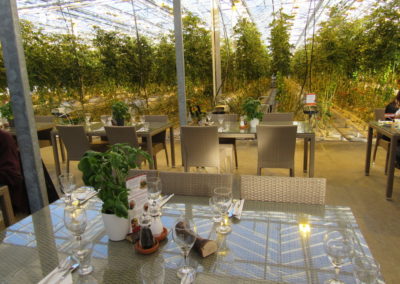
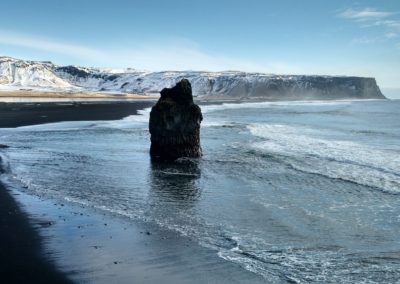
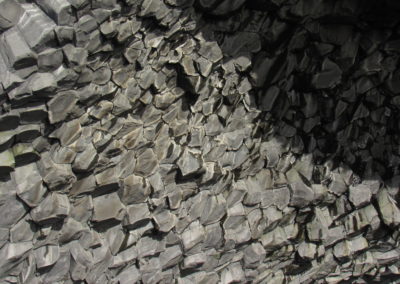
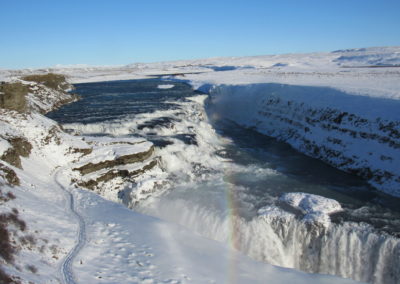
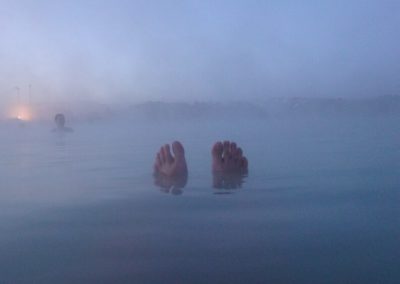
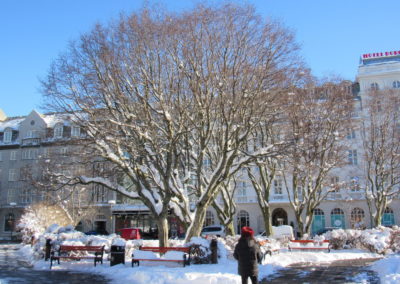
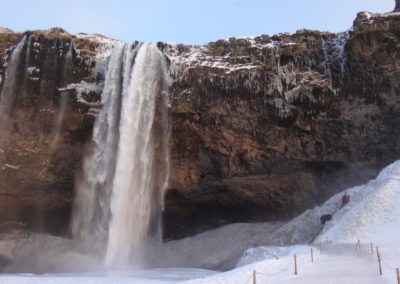
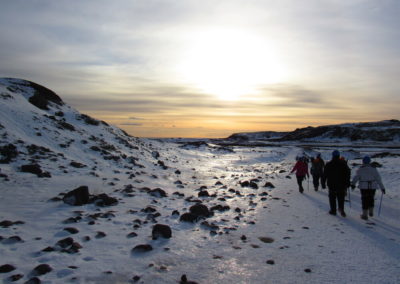
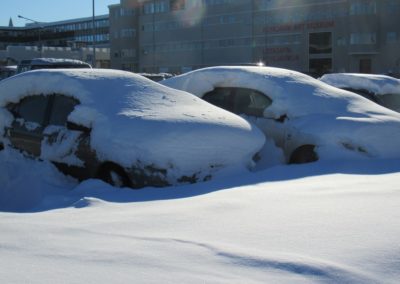
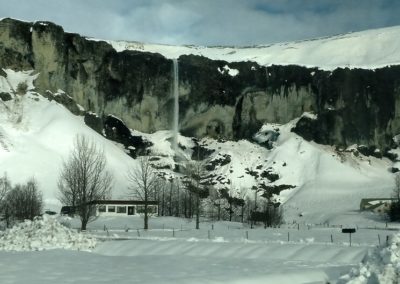
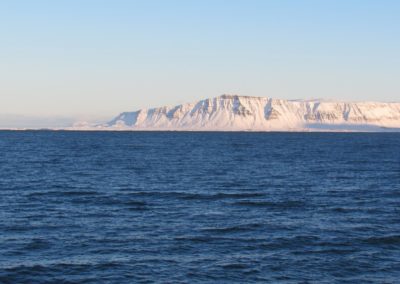
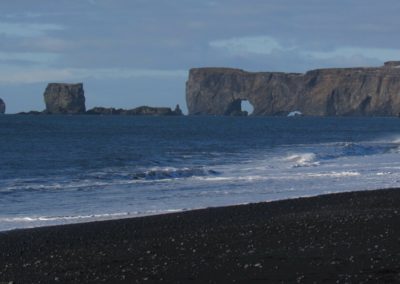
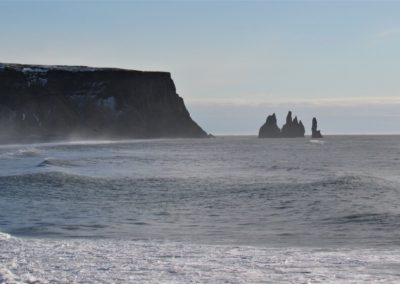
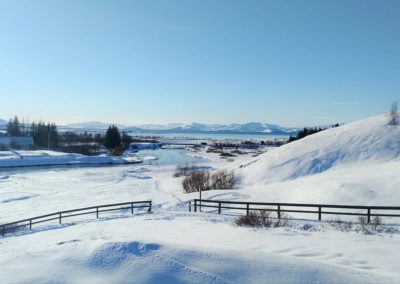
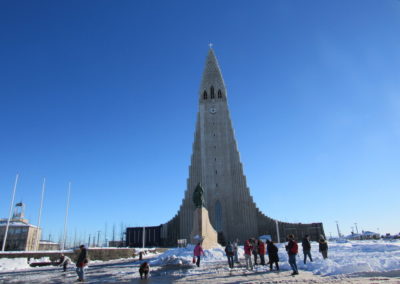
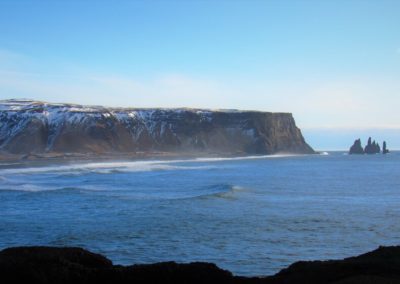

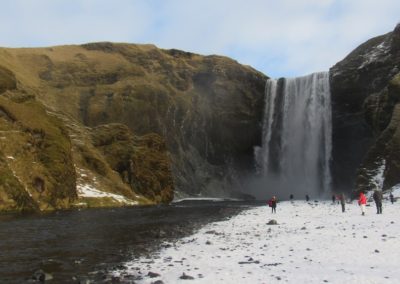
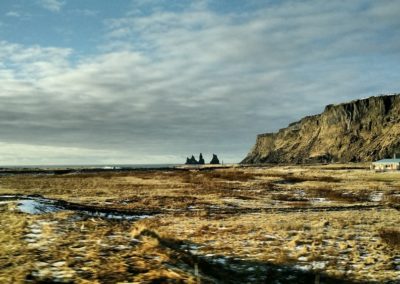
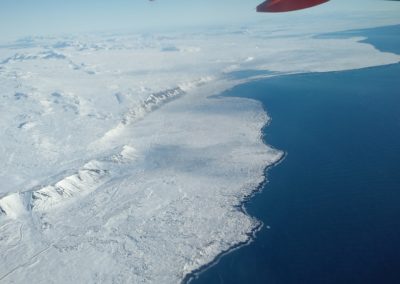
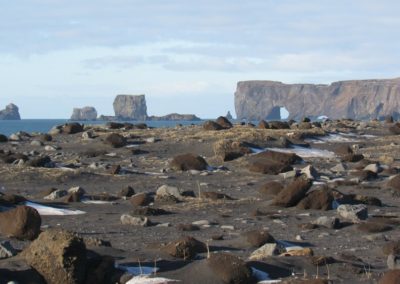
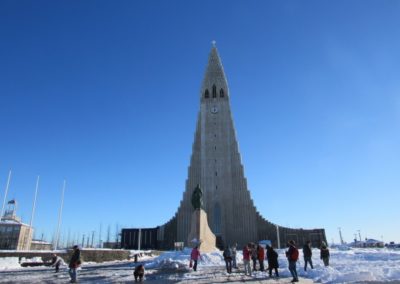
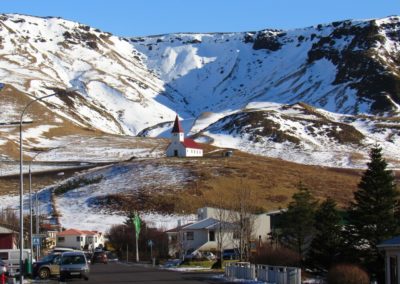
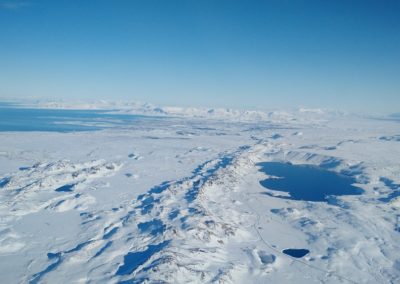
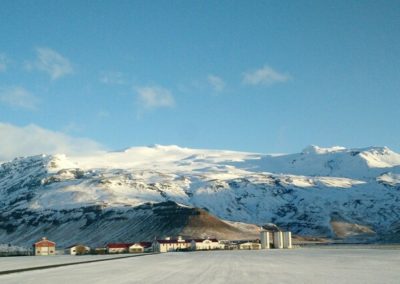
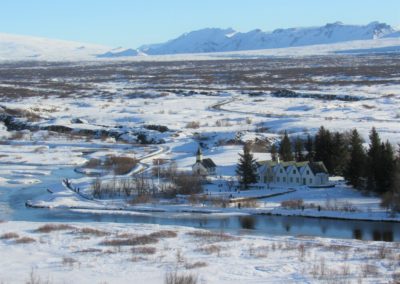


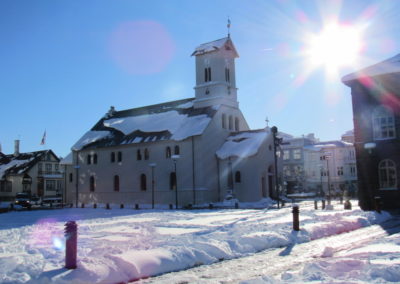
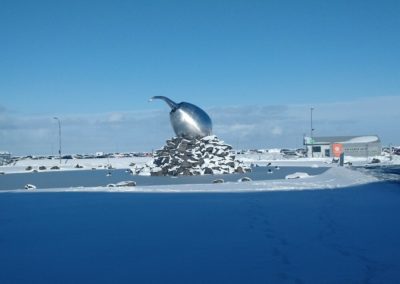
0 comentários